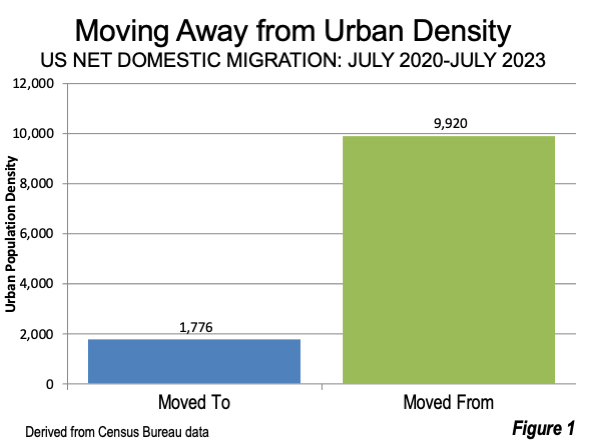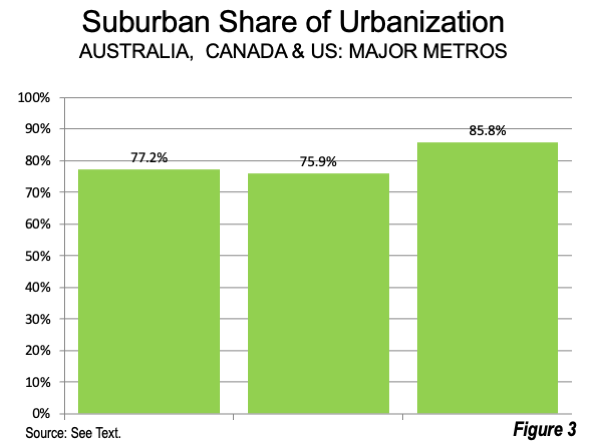
For more than 75 years America has been dispersing away from dense urban cores, with nearly all population growth in neighborhoods with a suburban form, whether inside urban core cities (Note 1) or within. This trend could well be accelerating and is now extending into counties that the Census Bureau determined had no urbanization at all in 2020. The trend toward suburbanization has long been opposed by urban planning orthodoxy, and increasingly state governments in California, Oregon, Massachusetts, and the city of Minneapolis. Public officials and key political figures such as California’s last two Governors, Jerry Brown and Gavin Newsom have endorsed policies to increase urban density. The dispersion occurring represents a rejection of that agenda.
In just the first three years of the decade, nearly five million US residents have migrated across county borders, according to US Census Bureau population estimates from July 1, 2020 to July 1, 2023. Each year, the Census Bureau estimates net domestic migration (migrating in minus migrating out), which is measured at the lowest level between counties. Only total net domestic migration is estimated by the Census Bureau, not other characteristics, such as income or race. Further, there are no data for areas within counties, such as cities (except where cities and counties have the same geographic boundaries, such as in Baltimore, Washington, Philadelphia, St. Louis and, of course New York, which consists of five complete counties).
The United States has become an overwhelmingly urban nation, with 80% of the population in urban areas and only 20% in the rural areas (which are all areas outside urban areas). The urban land area covers only 2.9% of the total US land area. At the 2020 Census, 265 million of the 331 million residents were in urban areas, which had a population density is 2,553 per square mile. The rural area population density is a much smaller at 19 per square mile. The 2020 Census was the third that classifies urbanization by the smallest unit of enumeration (census blocks) and as a result, urban areas are independent from all state, county and municipal borders. For example, the Philadelphia urban area is not only in Pennsylvania, but also New Jersey, Delaware and Maryland, while the Cincinnati metropolitan areas is not only in Ohio, but also Kentucky and Indiana. Urban areas are also different than metropolitan areas, with which they all are too frequently confused in academic literature.
Urban Areas
The Census Bureau defines urban areas after each census. Urban density is calculated by dividing the total urban population by the urban land area. In 2020, the average US overall population density was 94 per square mile (including both urban and rural areas). Among counties, the highest urban density is 74,800 in New York County (Manhattan). Of the nation’s about 3,100 counties and county equivalents, more than 1,000 had no urbanization in 2020. Urban density is a useful measure of urban influence at the county level.
It is notable that this net domestic migration has been overwhelmingly away from more intense urbanization — that is from counties with larger urban densities to counties with lower urban densities. Counties with higher urban population densities are often in or near the urban cores of the largest metropolitan areas.
Urban Density Weighted Net Domestic Migration
The relationship between net domestic migration and urban influence is illustrated by a population weighted analysis, which follows (Table).
The counties losing net domestic migrants had a weighted urban population density of 9,920 per square mile, almost four times the national urban density and only 12% below that of the US capital, Washington, all of which is urban (Figure 1).

Among the counties gaining net domestic migrants over the last three years, the population weighted urban density was 1,776 residents per square mile. This is 82% below the weighted urban population density of origin counties and approximately 30% below the national average urban density. This includes 224 counties that had no urbanization in 2020, which have gained 211,000.
The largest non-urban county gains were within generally within hybrid work commuting distance to larger metropolitan areas. For example, the largest gain was more than 5,000 net domestic migrants in Van Zandt County, which is to the southeast of Dallas-Fort Worth (photo above). Levy County, Florida gained more than 4,000 net domestic migrants and is located within hybrid commuting distance of Tampa-St. Petersburg and Orlando. Union County, Georgia gained more than 3,000 net domestic migrants and is within 2.5 hours of Atlanta, Chattanooga, TN and Greenville, SC, all of which could be comfortably reached for a remote worked needed in the office only a day or two per month.
Among the 46 states that had both gaining and losing counties, 37 had lower density net domestic destinations. In nine states, migrants from counties moved to higher urban densities, though only three moved to counties with higher than average urban densities (Nevada, 48% above, Arizona, 10% above and North Dakota 3% above).
New York out migrants had by far the greatest decline in urban densities, moving from an urban density of 33,900 moving to counties of just 1,800. This is indicative of the massive recent New York City outmigration. New York net domestic migration destinations had 95% lower urban densities than origins (Figure 2).

Significantly, migrants from states with strong densification programs (urban containment, compact city policy and infill requirements) generally moved to counties with lower urban densities, such as Colorado (45%) Washington (50%), Oregon and California (53%), Hawaii (69%) and New Jersey (73%).
US Urbanization: Preferences Rule
An economist colleague of mine often suggests that “preferences trump policies.” There is probably no better example than the historic rejection by people of higher densities, and the migration to lower densities, with their lower costs, greater space (inside and out) and comfort. Of course, some people prefer higher densities, but their numbers fall far short of a majority, essentially constituting a relatively small niche.
But as our City Sector Model has shown, even before the pandemic, 85.8% of US major metropolitan area residents lived in areas that are suburban in form (regardless of whether they are in core municipalities) rather than urban core in form. This is by no means limited to the United States. For example, in Canada (75.9%) and Australia (77.6%), the suburban share of major metropolitan areas population is reported to be only slightly below that of the United States (Figure 3) This is despite the fact that in both countries, anti-suburban policies have been far more comprehensive than in the United States. Additionally, our sample of 18 major world urban areas, both in the more developed and less developed, more than 95% of urban growth was in suburban areas between the 1950s and 2020s.

Meanwhile, the preference for suburban, and even rural living has become even stronger in the United States, and it seems that planning policies have been unable to stem the tide.
Wendell Cox is principal of Demographia, an international public policy firm located in the St. Louis metropolitan area. He is a Senior Fellow with the Frontier Centre for Public Policy in Winnipeg and a member of the Advisory Board of the Center for Demographics and Policy at Chapman University in Orange, California. He has served as a visiting professor at the Conservatoire National des Arts et Metiers in Paris. His principal interests are economics, poverty alleviation, demographics, urban policy and transport. He is co-author of the annual Demographia International Housing Affordability Survey and author of Demographia World Urban Areas.
Mayor Tom Bradley appointed him to three terms on the Los Angeles County Transportation Commission (1977-1985) and Speaker of the House Newt Gingrich appointed him to the Amtrak Reform Council, to complete the unexpired term of New Jersey Governor Christine Todd Whitman (1999-2002). He is author of War on the Dream: How Anti-Sprawl Policy Threatens the Quality of Life and Toward More Prosperous Cities: A Framing Essay on Urban Areas, Transport, Planning and the Dimensions of Sustainability.
Photo: 2010 Larry D. Moore, via Wikimedia under CC BY 4.0 license.
Notes: (back to reference)
Note 1: Many urban core cities have broad expanses of post World War II suburbanization, such as Phoenix, Austin, Dallas, Houston, Memphis, Nashville, Columbus, Indianapolis, Kansas City, Los Angeles, San Diego, Sacramento, San Jose, Las Vegas, Charlotte, Raleigh, Jacksonville and Orlando.
Note 2: Connecticut is not included in this analysis. There is no data because of its post-2020 geographical county reconfiguration.
Table (back to reference)
| Urban Population Density: Domestic Migration 2020-2023 | ||||
| County Gains or Losses by State/DC | ||||
| Population per Square Mile | ||||
| State/DC | Net Domestic Migration: Gain | Net Domestic Migration: Loss | Difference | Percentage Difference |
| Alabama | 1,210 | 1,382 | (172) | -12.5% |
| Alaska | 868 | 1,587 | (719) | -45.3% |
| Arizona | 2,812 | 1,726 | 1,087 | 63.0% |
| Arkansas | 1,372 | 1,192 | 180 | 15.1% |
| California | 3,188 | 6,726 | (3,538) | -52.6% |
| Colorado | 2,365 | 4,278 | (1,912) | -44.7% |
| Connecticut | ||||
| Delaware | 1,306 | |||
| District of Columbia | 11,281 | |||
| Florida | 1,803 | 5,994 | (4,191) | -69.9% |
| Georgia | 1,102 | 2,307 | (1,206) | -52.3% |
| Hawaii | 1,602 | 5,191 | (3,589) | -69.1% |
| Idaho | 2,225 | 4,355 | (2,129) | -48.9% |
| Illinois | 1,979 | 4,883 | (2,903) | -59.5% |
| Indiana | 1,770 | 2,436 | (666) | -27.3% |
| Iowa | 2,043 | 1,842 | 201 | 10.9% |
| Kansas | 1,536 | 1,810 | (274) | -15.1% |
| Kentucky | 1,217 | 2,505 | (1,288) | -51.4% |
| Louisiana | 1,245 | 2,589 | (1,344) | -51.9% |
| Maine | 1,072 | |||
| Maryland | 1,916 | 4,045 | (2,130) | -52.6% |
| Massachusetts | 1,409 | 7,080 | (5,671) | -80.1% |
| Michigan | 982 | 2,810 | (1,828) | -65.1% |
| Minnesota | 1,482 | 3,275 | (1,793) | -54.7% |
| Mississippi | 1,133 | 1,260 | (127) | -10.0% |
| Missouri | 1,412 | 3,346 | (1,934) | -57.8% |
| Montana | 1,484 | 451 | 1,034 | 229.3% |
| Nebraska | 2,003 | 2,562 | (559) | -21.8% |
| Nevada | 3,784 | 1,172 | 2,612 | 222.8% |
| New Hampshire | 1,125 | |||
| New Jersey | 2,162 | 8,026 | (5,864) | -73.1% |
| New Mexico | 1,855 | 2,289 | (434) | -19.0% |
| New York | 1,789 | 33,674 | (31,885) | -94.7% |
| North Carolina | 1,256 | 1,532 | (277) | -18.0% |
| North Dakota | 2,634 | 1,413 | 1,221 | 86.5% |
| Ohio | 1,800 | 2,879 | (1,079) | -37.5% |
| Oklahoma | 1,507 | 1,852 | (346) | -18.7% |
| Oregon | 2,255 | 4,814 | (2,559) | -53.2% |
| Pennsylvania | 1,823 | 8,458 | (6,636) | -78.5% |
| Rhode Island | 1,851 | 3,454 | (1,603) | -46.4% |
| South Carolina | 1,399 | 829 | 569 | 68.7% |
| South Dakota | 1,950 | 806 | 1,144 | 142.0% |
| Tennessee | 1,215 | 2,301 | (1,085) | -47.2% |
| Texas | 2,161 | 3,202 | (1,041) | -32.5% |
| Utah | 2,619 | 3,830 | (1,211) | -31.6% |
| Vermont | 1,027 | 1,842 | (816) | -44.3% |
| Virginia | 1,237 | 4,576 | (3,340) | -73.0% |
| Washington | 1,982 | 3,952 | (1,970) | -49.9% |
| West Virginia | 1,094 | 952 | 142 | 14.9% |
| Wisconsin | 1,167 | 3,767 | (2,599) | -69.0% |
| Wyoming | 1,176 | 2,314 | (1,137) | -49.2% |
| UNITED STATES | 1,776 | 9,920 | (8,144) | -82.1% |
| Connecticut excluded due to reconfiguration of counties (see text). | ||||
| Derived from US Census Bureau data | ||||












